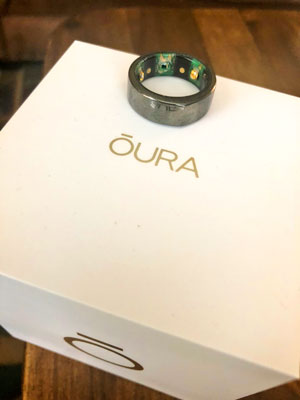The Oura ring: How your habits shape your health
Article and photo by Lisa Nicklanovich

The Oura ring is a wearable smart ring that tracks sleep and activity. According to Oura, the average person tosses and turns 37-40 times each night. In addition to tracking movement, Oura deciphers your sleep patterns, such as how much time you spend in each sleep stage (awake, light, REM, and deep sleep), how restorative your sleep was, and whether you got enough sleep. Your sleep and activity levels contribute to your overall readiness for each day.
If information is power, the Oura ring gives you superpowers. A titanium smart ring on your finger, the Oura ring has infrared LED sensors, temperature sensors, an accelerometer and a gyroscope that monitors and captures your body’s pulse, movement and temperature. Personalized insights are delivered straight from the most reliable source of information – your body.
In addition to being smart, the ring is also stylish and comfortable; it is meant to be worn all day and all night. I only take it off every few days to charge it in the provided charging station.
Oura measures from the arteries within your finger instead of the capillaries on the surface of your wrist. The ring doesn’t beep, buzz or bother you; there is an Oura app that you can access with a dashboard of information.
The dashboard on the app delivers three scores each day – readiness, sleep and activity. There are a number of contributors to each of the three categories and each contributor has a link on the app for more explanation. Oura on the web provides more tools to allow the user a deeper dive into the data.
To determine readiness for the day, the main data collected is resting heart rate, heart rate variability, activity levels, sleep, and temperature. For your sleep score, total sleep time and sleep stages are evaluated. It’s fascinating to see the sleep stages your body progresses through – how much REM, light, and deep sleep you actually get – all of which are important for different reasons.
Activity is tracked for those counting calories burned and steps taken with a suggested daily activity goal. If you think you will get applauded for doing 10,000 steps a day though – you won’t. The Oura ring provides data customized to the wearer that tells if you are in a state of recovery, strain or stability. The goal being looking for signs of balance.
I balked at a low readiness score one morning. Then, I realized that I could choose, based on this feedback, to prioritize rest and recovery. I had done a big hike the day before and had a not-so-great night’s sleep.
By establishing a baseline and then monitoring deviations from that baseline, you can better understand your body’s needs. This is part of the reason why NBA and WNBA players, NASCAR drivers and staff, and the men’s U.S. Alpine ski team have been wearing Oura rings. The ring can track relative body temperature, a core vital sign that can reveal key insight about your body status. Oura is being tested as more than a sleep and wellness tracker; it is also worn to improve athletic performance.
Oura has teamed up with research groups and health care workers, as well as invited Oura wearers to study how effective the ring is in being an advance indicator of oncoming symptoms of COVID-19 and signs of illness in general.
It will be interesting to see if Oura does more than the already amazing feat of being able to gather and interpret messages from your body about sleep and activity.
For more information, visit, https://ouraring.com.